If you’re looking to delete your Asana account, this blog is here to guide you through the process in a simple, step-by-step manner. Asana is a widely used project management platform that helps individuals and teams coordinate tasks, manage projects, and stay organized. While it’s a powerful tool for productivity, users may eventually decide to leave the platform for various reasons—such as switching to a different tool, reducing digital clutter, or addressing privacy concerns. In this Techy Manual guide, we’ll provide a brief overview of Asana’s core features to give context, explain why someone might want to delete their account, and then walk you through the exact steps needed to do so. Whether you’re closing an unused account or making a shift in your workflow, this guide will help you handle the process confidently and with clarity.
Things To Consider Before Deleting Your Asana Account
- Team Access: If you’re part of a team or organization, your departure might affect ongoing projects or task assignments.
- Admin Roles: If you’re an admin, make sure to transfer ownership or admin rights to another member before deletion.
- Subscription Plan: Cancel any paid subscriptions to avoid future charges before deleting your account.
- Backup: Consider exporting important data or reports if you might need them later.
- Workspace vs. Account Deletion: Deleting your account does not necessarily delete the workspace; understand what you’re removing.
- Third-Party Integrations: Disconnect any apps or integrations linked to your Asana account.
- Alternative Solutions: If you’re facing issues, explore Asana’s support or help center for potential solutions before taking final action.
What Happens When I Delete My Account?
- Permanent Loss of Access: You will no longer be able to log in or access any data associated with your Asana account.
- Tasks and Projects Remain: Tasks and projects you created may still exist in shared workspaces, but your name will appear as a “Former Member.”
- No Recovery Option: Account deletion is permanent—once deleted, your account and personal data cannot be restored.
- Email Disassociation: Your email address will be removed from Asana’s system, allowing you to use it to create a new account in the future if desired.
- Workspace Memberships Removed: You will be removed from all teams, projects, and workspaces you were a part of.
- Billing Impact: If you are the billing owner, your account deletion may affect active subscriptions—ensure billing responsibilities are transferred.
Follow Step-By-Step Process To Delete Asana Account
- Open your account, go to profile and click on settings.
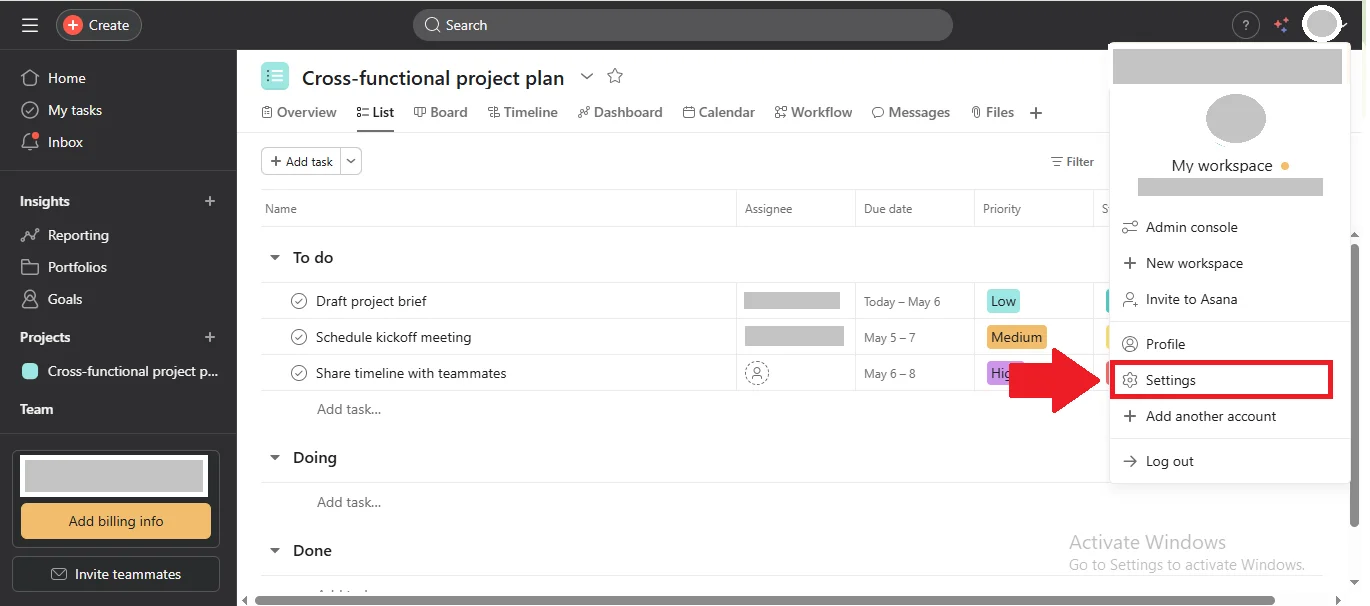
- Tap on Account and then delete my account.
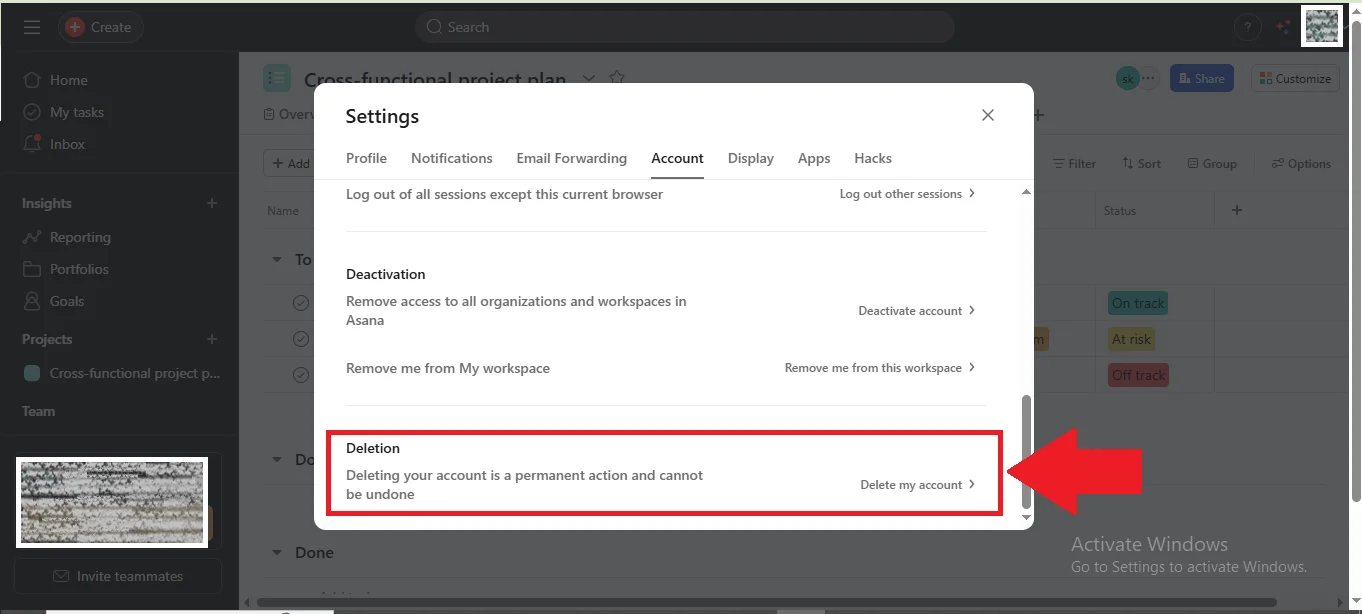
- Select confirm to delete.
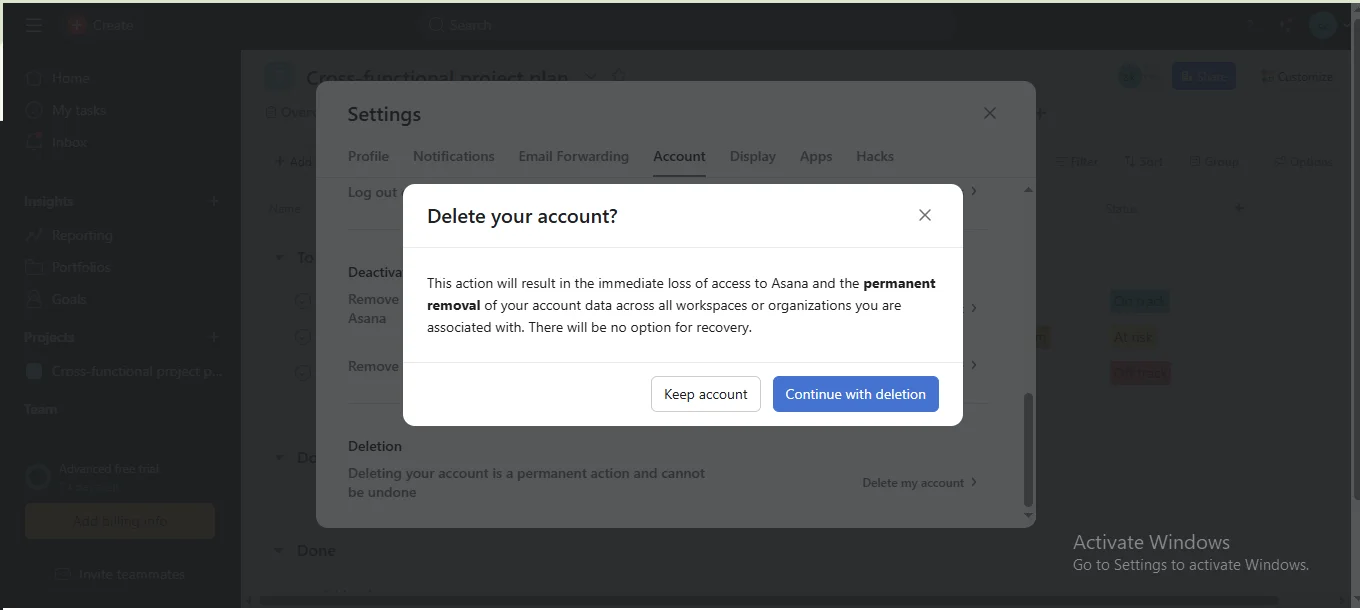
- Select the reason to delete your account.
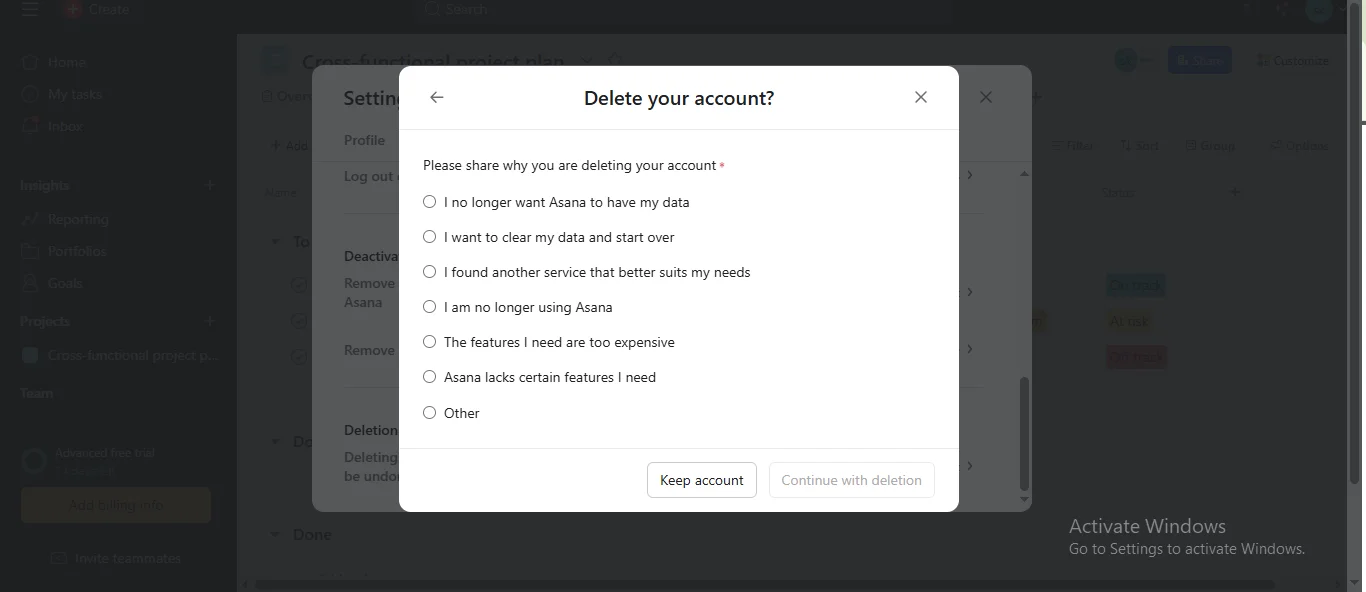
- Write delete to delete your account.
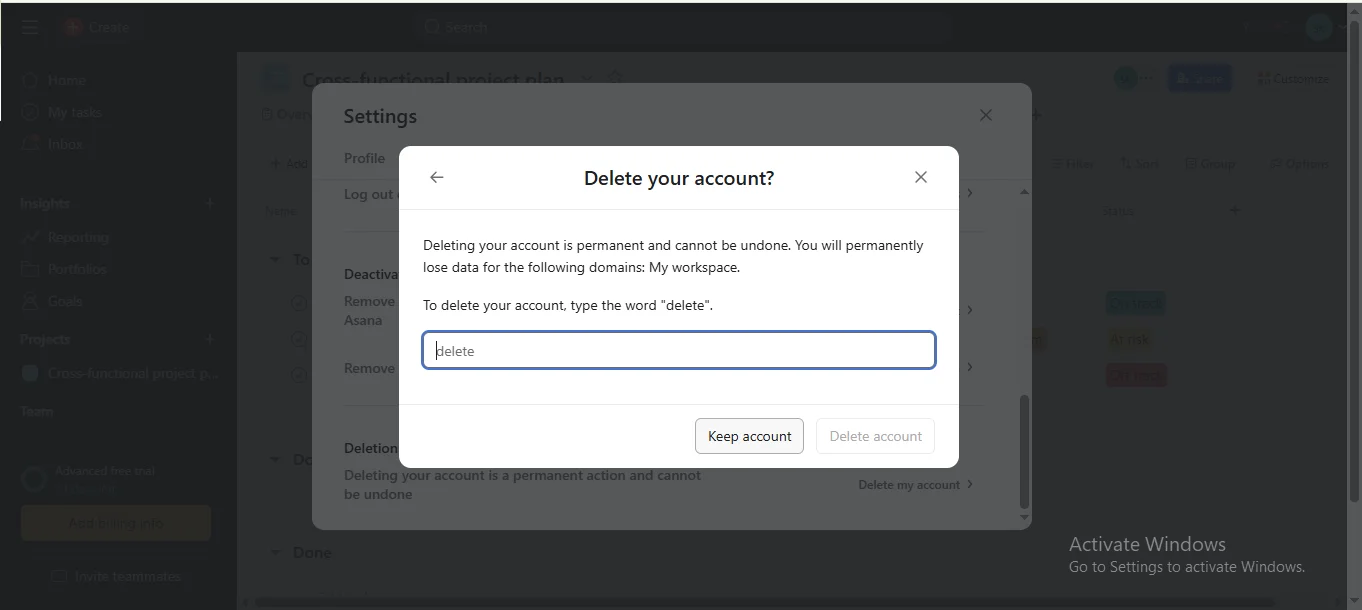
Deleting The Asana Account Of A Deceased Family Member
Losing a loved one is never easy, and managing their digital accounts can add another layer of emotional difficulty. If your family member had an Asana account that is no longer needed, you can request its deletion by contacting Asana’s support team. Here’s a detailed guide on how to navigate the process.
What You Will Need
Before contacting Asana, gather the necessary documentation to verify both the death and your relationship to the deceased. This helps ensure the request is handled securely and in compliance with privacy policies.
- Death Certificate: A scanned or digital copy of the official death certificate is usually required.
- Proof of Relationship: Documentation proving your legal relationship to the deceased (such as a will, legal power of attorney, or identification showing familial ties).
- Email Address Linked to Asana: The email address used to register the Asana account is essential for locating and verifying the account.
Reaching Out to Asana
To begin the process, go to the Asana Support Contact Page. Follow these steps:
- Scroll down to the support contact form.
- Choose a category like “Account Access” or “Privacy & Security.”
- Fill in the required fields, including your contact information and the deceased user’s email.
- Attach the necessary documents (death certificate, proof of relationship).
- Clearly title your message (e.g., “Request to Delete Account of Deceased Family Member”).
Asana does not typically allow third-party access to an account due to privacy laws, but they will act to close or remove the account upon proper verification.
Explaining the Situation
In your support message, be as clear and respectful as possible. You might say something like:
“Hello, I am writing to request the deletion of an Asana account belonging to my late [relation], [Full Name], whose account was registered with [email address]. I’ve attached a copy of the death certificate and documents verifying my relationship. Please let me know if any further information is needed to proceed.”
This kind of clear and compassionate explanation helps the support team expedite your request.
Account Access and Options
Asana generally does not provide direct access to the contents of a deceased user’s account, in line with data protection regulations. However, once your request is verified, Asana may take the following actions:
- Permanently delete the account of the deceased user.
- Remove the user from any shared workspaces or organizations.
- Preserve project data for other team members if the account was part of a collaborative workspace (the data remains accessible to teammates unless they choose to delete it).
- In rare cases, they may export certain data if legal requirements or prior user permissions allow.
The process may take several days, depending on the complexity of the request and the documentation submitted. Asana typically handles such cases with care and confidentiality.
Deactivate Asana Account
- Open your account, go to profile and click on settings.

- Tap on Account and then deactivate my account.
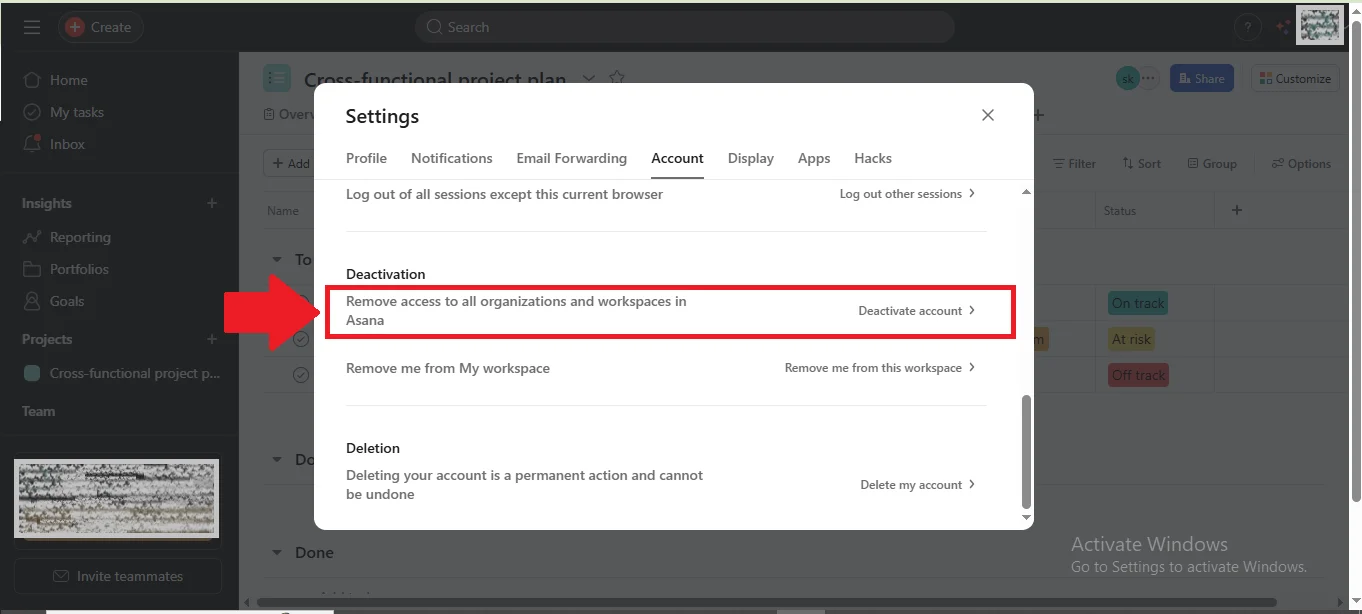
- Give a reason to confirm to deactivate your account.
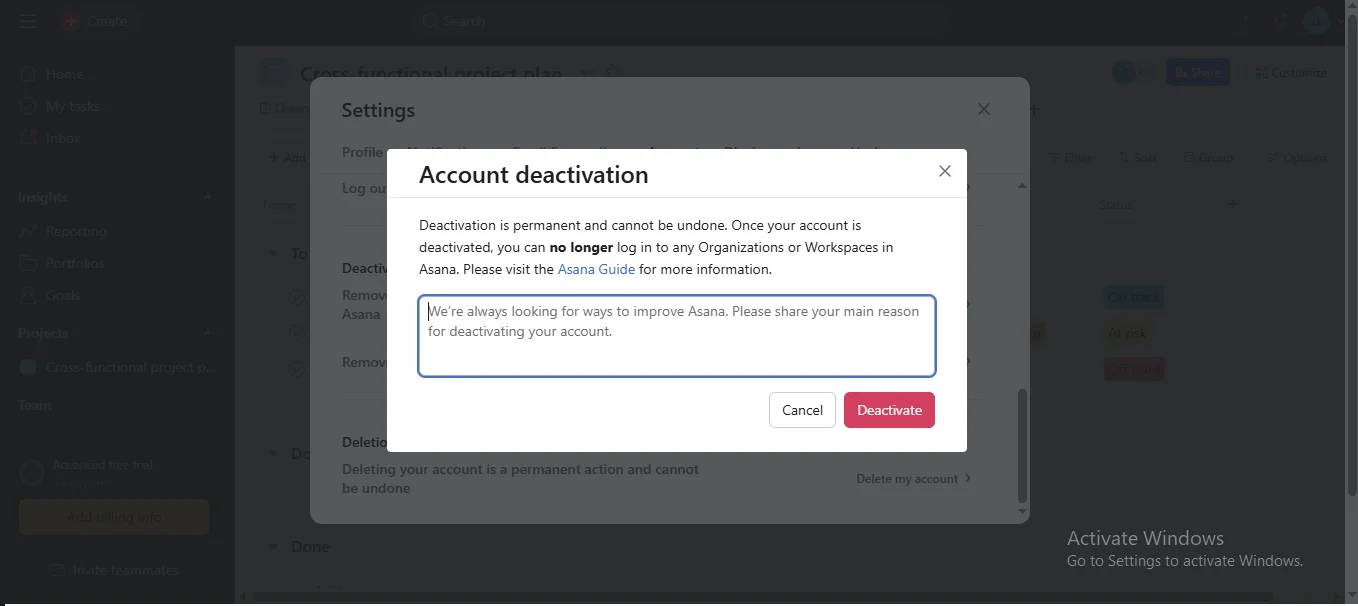
Restore Account Incase Of Change Of Mind
Asana does not offer a way to restore an account once it has been permanently deleted. According to Asana’s official support documentation, deleting your account is an irreversible action. Once you confirm deletion, your personal data and account access are permanently removed from the system.
Conclusion
Deleting your Asana account is a significant step, especially if you’ve used the platform to manage important tasks or collaborate with teams. Whether you’re simplifying your digital life, switching tools, or addressing privacy concerns, it’s important to understand the permanent nature of this action and consider alternatives such as exporting data or leaving specific workspaces. This guide has walked you through everything from preparation to contacting support in sensitive cases. Make sure to review your options carefully before proceeding—because once your account is deleted, recovery is not possible.
